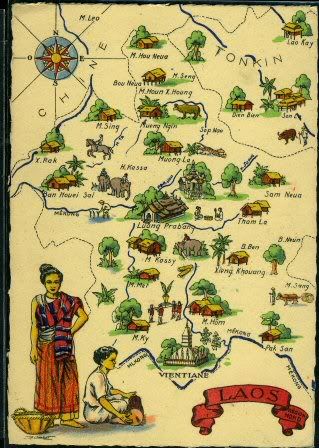As an applied example, when I wrote my Lovecraftian historical horror story "What Hides and What Returns," there were questions I had to address as a writer in order to bring a reader into Laos, minimizing confusion with a minimum of compromise.
To that end, I set the story just after 1893 when Vientiane and Champassak had been bundled together with Luang Prabang to create a state that was a French protectorate called Laos, and a Lao narrator who worked often enough with the falang that he might reasonably refer to it as Laos. For stories set earlier than 1893, we have to be even more aware of anachronisms that take us out of a story, that suspension of disbelief.

When we're using an ethnic Lao narrator, one might argue, it may not matter and you could even use a non-standard romanization instead of Long Tieng (Long Cheng), or Luang Prabang (Luang Phrabang).
Radically, there could be great power in this: Lao names and geography written by Lao the way Lao themselves feel it should be spelled, and not just the way some falang missionary or policy wonk decided we should write the names of our cities and landmarks. That would be significant step towards decolonization.

But we also need to decolonize time. Not everyone uses the solar calendar, after all.
For Lao, the year 2011 is mostly 2554, at least since April (Deuane Si or Mesa), depending on the system we're using. These days, we're following a system that figures 543 BC as Year 1.
The Lao calendar has elements of Sino-Vietnamese and Thai-Khmer calendars, and are based on a solar-lunar mix.
Lao years are reckoned by solar phases, but our months are determined by lunar phases. This is different from European and American calendars where the months are also determined by the sun. There is also reportedly an earlier Lao system in which year one would correspond with the year 638 BC, just to complicate things.

It's not just a case of calibrating a time machine by simply setting a dial + or - 534 years.
As a further example of the complicated nature of Time, especially in a decolonized Steampunk setting, bear in mind the traditional Chinese time-keeping system. Here we see the hours associated with different creatures of the zodiac. Chinese hours are actually about two Western hours:
23:00 – 01:00: 子 RatAs a further example of the complicated nature of Time, especially in a decolonized Steampunk setting, bear in mind the traditional Chinese time-keeping system. Here we see the hours associated with different creatures of the zodiac. Chinese hours are actually about two Western hours:
01:00 – 03:00: 丑 Ox
03:00 – 05:00: 寅 Tiger
05:00 – 07:00: 卯 Rabbit
07:00 – 09:00: 辰 Dragon
09:00 – 11:00: 巳 Snake
11:00 – 13:00: 午 Horse
13:00 – 15:00: 未 Goat
15:00 – 17:00: 申 Monkey
17:00 – 19:00: 酉 Rooster
19:00 – 21:00: 戌 Dog
21:00 – 23:00: 亥 Pig
Talking about time in a truly multicultural Steampunk world should take this into account. Time travel a la H.G. Wells' classic 'The Time Machine' now becomes interestingly complicated when we consider whose sense of time applies. The visitor, or the visited?
But let's look at an additional challenge for the role of time in Lao fiction: In Laos, we can run into big headaches because time is not homogeneous among the 100+ cultures who live within its frequently shifting borders.
To elaborate on the importance of this question, consider that in the mountains and jungles of Laos, highlanders such as the Hmong used time as the measure of distance. "It's two days of walking to the next village." Miles, kilometers, etc. are very abstract concepts to them in the old days, let alone 20,000 leagues under a sea to people born in a landlocked nation.
This is, of course, just the tip of the temporal iceberg, but I think it opens up some very intriguing questions for better Steampunk set among Southeast Asian cultures. And I hope it raises the bar for anyone who decides to use a English protagonist using a modified Mayan time travel device to visit ancient Mayao in the highlands of Annam to discover the secret to immortality or some other fantastic scenario.

No comments:
Post a Comment